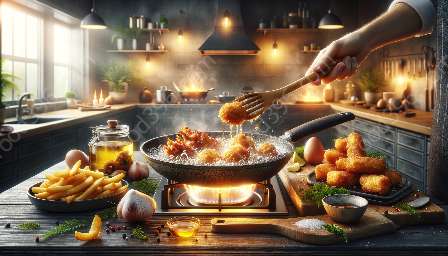Pressure frying is a specialized cooking method that involves the use of pressure to fry foods. It is a technique that offers unique advantages in the realm of frying and food preparation. In this article, we will explore the intricacies of pressure frying, its compatibility with traditional frying methods, and its role in food preparation techniques.
The Basics of Pressure Frying
Pressure frying is a cooking method that combines pressure cooking and frying. It involves sealing food in a pressurized chamber with hot oil or fat, allowing for faster cooking and increased flavor infusion. The high pressure inside the fryer raises the boiling point of water in the food, resulting in a quicker cooking process and a crispy outer texture.
Advantages of Pressure Frying
Pressure frying offers several distinct advantages over traditional frying methods. Firstly, it significantly reduces cooking time, making it an efficient option for commercial kitchens and restaurants. The pressure seals in the food's natural juices, ensuring that it remains tender and flavorful. Additionally, pressure frying creates a crispier texture on the outside while preserving moisture on the inside, resulting in a perfectly cooked product.
Furthermore, pressure frying can be a healthier option as it requires less oil compared to traditional frying methods. The pressure helps the oil penetrate the food quickly, which means less oil is absorbed during the cooking process. This results in lighter, less greasy dishes that are more appealing to health-conscious consumers.
Compatibility with Traditional Frying
Pressure frying complements traditional frying methods by offering a faster alternative that retains the desired texture and flavor. It can be used for a wide variety of foods, including chicken, fish, and vegetables, providing a crisp and juicy result while significantly reducing cooking time. Many popular fast-food chains utilize pressure frying to create their signature dishes, showcasing its compatibility with traditional frying in commercial settings.
Applications in Food Preparation Techniques
Pressure frying is integral to food preparation techniques, especially in large-scale operations. Its ability to quickly and evenly cook food makes it an essential tool for catering, banquets, and fast-food establishments. The efficiency and consistency of pressure frying contribute to streamlining kitchen operations and meeting high customer demands.
Moreover, pressure frying also plays a role in preserving the nutritional value of food. By sealing in natural juices and minimizing oil absorption, it helps maintain the integrity of ingredients, making it a valuable technique for institutions that prioritize quality and nutrition in their menu offerings.
In Summary
Pressure frying is an innovative cooking method that leverages the power of pressure and heat to achieve delicious, efficiently cooked dishes. Its compatibility with traditional frying methods, coupled with the advantages it offers in terms of cooking time, texture, and nutritional value, establishes pressure frying as a valuable technique in the realm of food preparation. Whether in a commercial kitchen or at home, understanding and mastering pressure frying can open up new culinary possibilities and improve the overall quality of fried foods.

